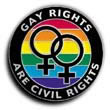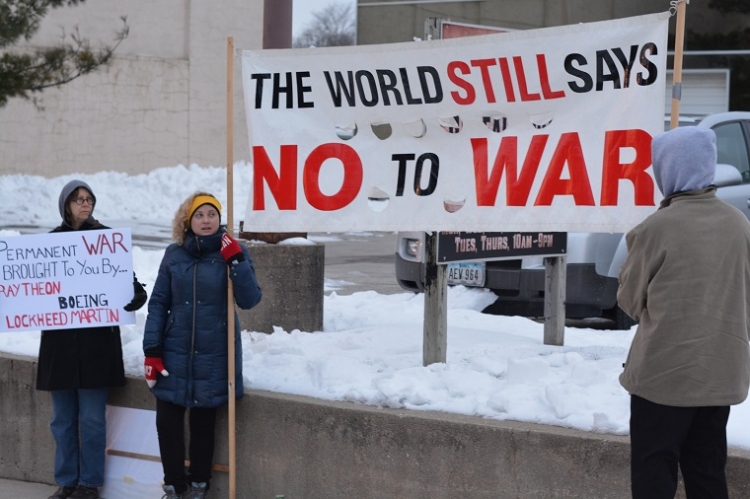Why Stonewall Matters Today
ACTIVISM, SEXUALITIES, 24 Jun 2019
Andy Thayer – Jacobin Magazine
22 Jun 2019 – Stonewall wasn’t just an uprising for LGBT rights — it was also part of a broader movement that fought racism, war, and poverty. To go beyond today’s tepid gay activism, we need to remember its anti-capitalism.
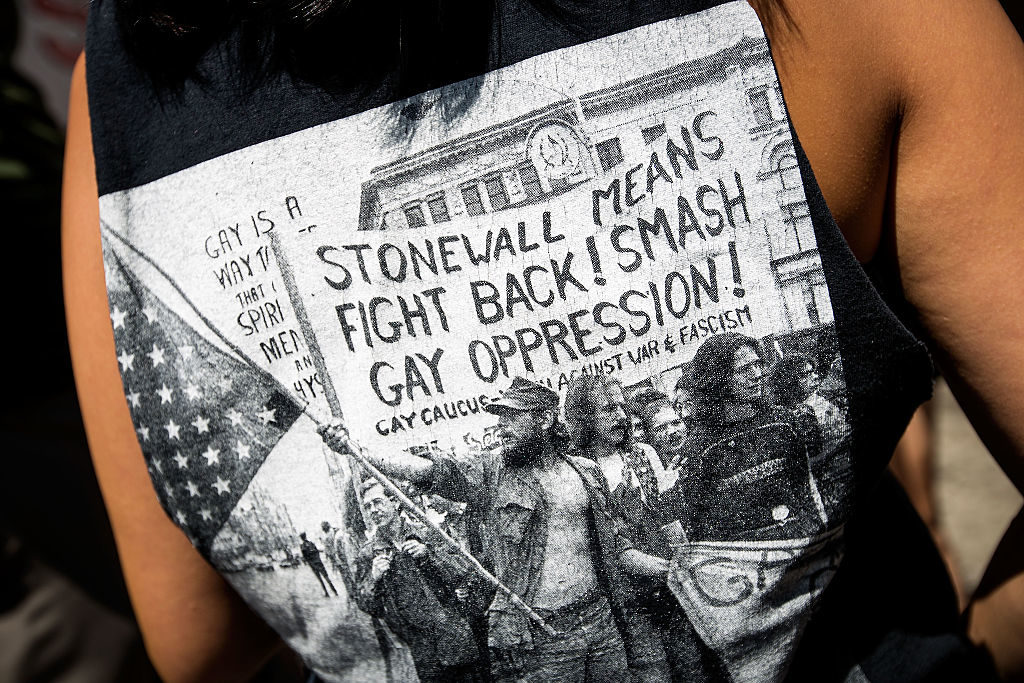
A woman wears a t-shirt honoring the gay rights movement outside the Stonewall Inn on June 24, 2016 in New York City.
(Drew Angerer / Getty Images)
The police raid on New York’s Stonewall Inn fifty years ago this month is widely viewed as the most pivotal event in LGBT* history, spawning a movement which prompted many millions around the globe to come out of the closet and fight for their freedom. But for all its significance, the movement launched by the 1969 Stonewall Rebellion remains poorly understood today, even by many radical LGBT people who sing its praises.
Black Lives Matter activists today make the legitimate complaint that “moderates” defang the radical ideas of such bold predecessors as Martin Luther King, Jr, Ella Baker, Malcolm X, and the Black Panther Party by either outright distorting their ideas or ignoring them altogether. Likewise, on this half-century anniversary of Stonewall, we should expect similar treatment from “mainstream” LGBT people, liberals and conservatives alike, for whom Stonewall is an occasion for vacuous self-congratulation, and parades of rainbow-themed beer floats and politicians.
Stonewall was a profoundly radical event, and not just because a multiracial group of LGBT people rioted for a few nights against the police, turning a routine aspect of anti-gay oppression on its face.
The Stonewall movement unapologetically challenged generations of gender stereotypes, a huge contrast with the moderate “homophile” movement that had preceded it. Whereas homophile activists had obsessed at proving how “normal” and “unthreatening” LGBT people were to society as it already existed, Stonewall-era activists consciously saw society itself as sick and in need of radical revision.
Whereas today only a radical minority of LGBT activists decry racist violence by the police and US military to the point of calling for the abolition of both institutions, during the Stonewall era, many LGBT activists supported the overtly revolutionary Black Panther Party as it faced a nationally coordinated campaign of police violence.
Whereas today most LGBT nonprofits have nothing to say about Americas war’s abroad, or worse, wrap themselves in US patriotism, most local Stonewall-era organizations adopted the name “Gay Liberation Front” (GLF) in conscious solidarity with Vietnam’s “National Liberation Front” fighting against US troops. They rejected US nationalism and hoped the Vietnamese would defeat the United States and force it out of their country.
In short, the Stonewall movement was the antithesis of respectability politics, representing instead a radical anti-oppression politics that thoroughly critiqued all of US society.
Despite some ham-fisted attempts to whiten the event, most firsthand accounts note that the Stonewall Inn was a lower-class “dive bar” with a racially mixed clientele, including sexual minorities of all sorts. Recent years have seen vigorous debates about the gender identity, race, and sexual orientation of the person who threw the first brick in retaliation for the police raid, endlessly trying to determine if it was a trans woman of color who threw the brick, a lesbian woman (race unspecified) who actively struggled as police threw her into a squadrol, or someone else entirely.
But aside from debunking any notion that it was the upper-crust, Human Rights Campaign cocktail-sipping crowd who rebirthed our movement, the debate is pointless. That’s because the riot at Stonewall wasn’t unique.
There were at least three other LGBT riots in reaction to violent police raids on LGBT venues between 1966 and 1969. Furthermore, given how poorly documented Stonewall was at the time — just a snarky Village Voice article and a few photographs — it’s likely that there were other LGBT riots around the same time that are now lost to history.
What made Stonewall special was not the riot itself, but the specific historical context in which it took place, and how that context in turn prompted LGBT people to begin organizing a radical movement in the weeks and months following. It was the post-riot organizing, not the riot itself, which caused it to gain iconic status in our history.
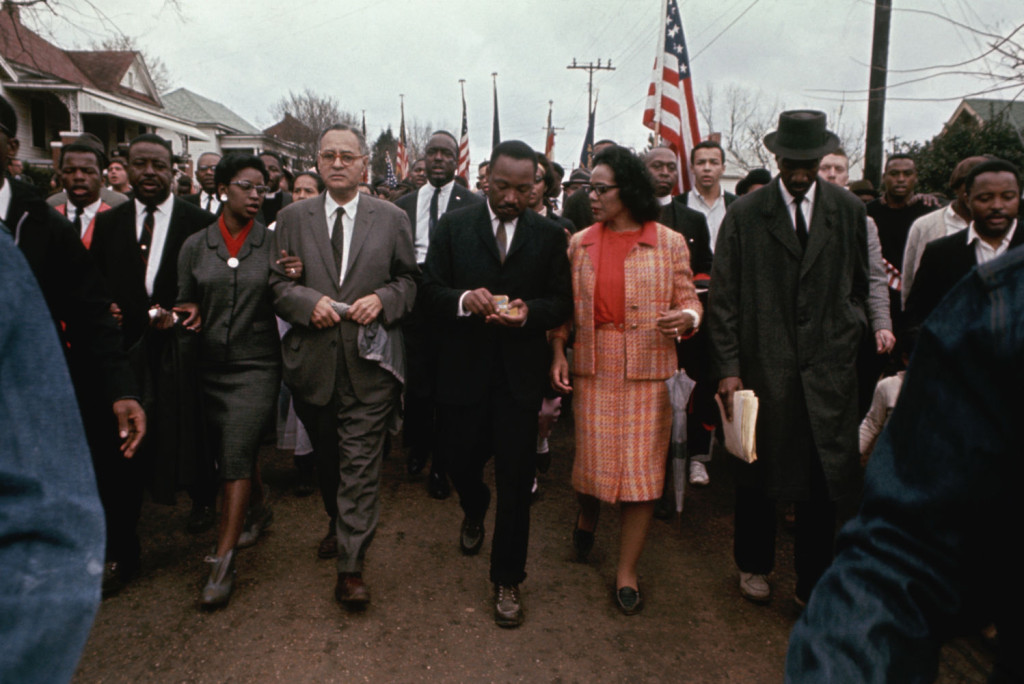
King and his wife, Coretta, march with other civil rights activists through a neighborhood in Selma in 1965. Photo: Flip Schulke/CORBIS)
The Power of the 1968–73 Movements
The period 1968 through 1973 is one of a handful of brief moments in modern US history where not only LGBT people, but antiwar activists, people of color, the environmental movement, the labor movement, and women made profoundly rapid and sweeping advances.
While the legislative gains of the gay movement were meager during this period, the movement-building they launched was critical to all subsequent gains. For the first time in US history they established the gay movement as a widely recognized public entity that newly coming out LGBT people could readily join and begin organizing with, a crucial step in helping millions of others come out and thus expand the self-identified gay community to millions of people.
LGBT people were part of a huge ferment of activism. Black Power activists, through the example of the Black Panther Party’s “survival programs,” forced a quadrupling of the food stamps program to feed poor people. A profoundly racist Nixon administration was forced to introduce affirmative action on a national scale to an extent never seen before or since. A revitalized women’s movement organized in the streets and broke the law to take direct action in providing abortion services, leading a Nixon-packed, anti-abortion Supreme Court to concede Roe v. Wade in 1973.
Rank-and-file caucuses in the auto workers, mine workers, Teamsters, and postal workers shook up sclerotic, viciously corrupt, and anticommunist union leaderships, leading wildcat strikes against racist bosses, victimizations of union activists, and speedups, making 1973 a high point of workers’ real wages in the United States that has been unmatched since. A massive environmental movement was seemingly birthed overnight, forcing the pro-business Nixon administration to sign sweeping environmental legislation establishing the Environmental Protection Agency and rapidly expanding the power of the previously feeble Clean Air, Clean Water, and Endangered Species Acts.
And finally, in alliance with Vietnamese fighting for their country’s self-determination and activists around the globe, an antiwar movement penetrated virtually every aspect of US society — most importantly the military. It forced the defeat of the most powerful imperial power known to history. For nearly two decades afterwards, the “Vietnam Syndrome” stayed the hands of subsequent US presidents from launching full-scale invasions against all but the smallest nations. As such, it undoubtedly saved millions of black and brown lives during that period.
None of these movements could claim ultimate victory. Many today are hollowed out and in disarray. But at their height they exercised a power that forced dramatic concessions from the other side — gains that Trump and all his predecessors have striven mightily to roll back.
Short of a revolutionary overthrow of the old order, all movements in history eventually fall. But the course they take is never linear: sometimes they are punctuated by profound shocks, such as the Stonewall Rebellion in the positive sense, and sometimes in the negative sense by events like the Great Depression and the triumph of Nazism which killed off the world’s first gay movement centered on 1930s Germany. Most signs today point to the LGBT movement in the US having peaked several years ago, before Trump took office.
In stark contrast with the all-volunteer, member-driven organizations of the Stonewall era, today’s LGBT organizations are staff-driven groups dependent on foundation money and rich donors who directly or implicitly control their politics, always making sure not to displease their powerful sponsors. “Leaders” cycle through an endless revolving door of nonprofits, foundations, consultancies, and posts of the Democratic Party and its campaigns.
Rather than the gutsy organizations of the Stonewall era, our movement today is dominated by sclerotic “nonprofit” organizations run by executive directors with six-figure salaries hobnobbing at black-tie galas. Actual radicalism has been replaced by radical talk of academicized “queer theory,” and “virtual” astro-turfing and social media substitute for on-the-ground, grassroots organizing.
Should we be surprised that every week seems to bring yet another attack on LGBT rights, especially the rights of trans people?
If we truly want rapid, sweeping changes such as that brought about by the Stonewall-era movement, we have to ask: what is it that caused those activists to organize so effectively?
Mass Engagement plus Major-Party Disgust
Several accounts of the movement preceding Stonewall note that a section of the old homophile movement, birthed in the early 1950s, was increasingly influenced by the radicalism of the growing black, women’s, and antiwar movements. But noting these general influences still fails to account for why activists changed course so radically following the Stonewall riot, in contrast to the lack of such a course change following the handful of LGBT riots that came before it, such as the 1966 Compton Cafeteria riot in San Francisco.
LGBT historians have noted that several the leading Stonewall-era LGBT activists were people who had been active in other movements before Stonewall, especially the movement against the US war in Vietnam. But none have looked at the 1968–69 debates within the antiwar movement, let alone the rapid developments in the 1968–69 Black Power movement, both of which profoundly influenced these activists.
They thus fail to explain the politics which young activists took into the Gay Liberation Fronts. It was, in fact, this politics — a politics of direct action and self-emancipation — that allowed a mass LGBT movement to be birthed after Stonewall, and profoundly transformed many LGBT people’s perceptions of themselves.
As I’ve written elsewhere, 1968–1973 was one of a handful of brief periods in modern US history where two essential, equally necessary, factors converged to produce the most sweeping and rapid progressive changes in LGBT history: (1) mass social engagement; and, much less noted by historians, (2) mass alienation from the established political parties. Both factors produced the “perfect storm” which birthed the radical movements of 1968–73, and in turn forced the rapid progress that makes this period a beacon for those who desire rapid progress today.
To understand why this occurred, we first must wind the clock back a few decades earlier. The mass social engagement in politics associated with the 1960s can be traced directly to the period immediately after World War II. Immediately following the war, black veterans who had risked their lives fighting for “democracy” came back to Jim Crow segregation and the violent racism which upheld it. The 1954 Brown v. Board of Education of Topeka Supreme Court decision formally outlawed segregation but did nothing to change it; in fact, effectively driving home the lie that American democracy applied to everyone.
This contradiction between promise and reality was a principal driving force behind the epic 1955–56 Montgomery, AL bus boycott which launched a reluctant Martin Luther King, Jr on his path to becoming a civil rights hero. The movement drew its power not only from the mass social engagement of that city’s black community, but, just as importantly, from the new movement’s profound distrust of both major political parties. Whereas King’s father and his generation of black activists had openly embraced the Republican Party as the party of freedom ever since the Civil War, activists of King, Jr’s generation asked what that party had done for black people since the abolition of slavery.
Since the Democrats were the party of the Klan and Jim Crow, both parties presented a brick wall to blacks in the South who wanted change. They could draw few other conclusions than that their freedom would have to come by their own efforts.
It was in this spirit of independence and self-emancipation that they carried the movement through the great 1963 March on Washington, where both parties were held at arms’ length and the organizers refused to knuckle under to Attorney General Robert Kennedy’s demand that they call off the march. It was in this way that they forced the great civil rights legislation of the mid-1960s and put an end to formal apartheid in the United States.
A similar spirit of independence and self-emancipation was forced on LGBT people by major events shortly before Stonewall, which is why the reaction to that police attack was very different from the reactions to similar police violence before it.
On April 4, 1967, Martin Luther King, Jr became a hero to the antiwar movement, including its young activists who would later populate the LGBT movement, when he gave his landmark Riverside Church speech against the Vietnam War. For this, he was roundly denounced in hundreds of newspaper editorials. Both leading liberal and conservative commentators, as well as mainstream civil rights leaders, came out against him. Only rank-and-file civil rights activists and the fledgling antiwar movement were in his corner.
One year to the day later in Memphis, King was assassinated while supporting striking sanitation workers. Riots rocked virtually every city in the United States, an expression of how deeply alienated most blacks were from American “democracy.” The person who had bent over backwards to allow it to reform itself was instead murdered in racist violence, suggesting to many that the political system and its parties were irredeemably bankrupt.
Still, many young white activists retained some faith in the system. In the 1964 election, the largely white Students for a Democratic Society had supported Lyndon Johnson, who campaigned as a “peace” candidate versus the overtly pro-war, ideologically right-wing Barry Goldwater. “Half the Way With LBJ” was the young antiwar activists’ slogan — they liked his domestic programs, but disliked the war, and believed his promises to end it. Upon winning the election, LBJ dramatically escalated the Vietnam War.
Four days later, King was assassinated, as was Robert Kennedy two months later. Kennedy had rebranded himself as an “antiwar” candidate, electrifying many young activists; now he was dead.
Going into the August 26–29, 1968 Democratic Convention in Chicago, many young antiwar activists still held out hope that the system might correct itself. Many were aligned with the remaining Democratic “antiwar” candidate, Eugene McCarthy. The pro-war candidate, Vice President Hubert Humphrey, had not won a single state primary. Between them, Kennedy and McCarthy had racked up 68.7 percent of the Democratic primary vote. There was no way the pro-war candidate could win, right? Outside of the convention hall, Mayor Richard J. Daley’s police force bludgeoned out of the heads of antiwar activists any remaining hopes in American democracy.
Faith in American democracy and its two political parties had been shattered among a huge section of young black and white activists — many of the same people who a few months later would begin to swell the ranks of the newly formed Gay Liberation Front groups that sprang up all over the country. With the politicians and their parties bankrupt, change would have to be made by the people themselves.
Rather than try cajoling experts and politicians into “tolerating” and “accepting” LGBT people as the old homophile movement had tried to do, the task now was to reject them and begin to build a new society for themselves. Denouncing self-hatred, the old deferential hat-in-hand approach of their homophile forebearers, the new activists proudly proclaimed “Gay is Good!” much as earlier Black Power activists proclaimed “Black is Beautiful!” and women were celebrating “Women Power!” For all their previous experience in organizing, very few activists from the old homophile movement of the 1950s and 1960s made the transition to the radical new movement.
A Split in the Movement
The winning of formal legal equality for blacks in the mid-1960s prompted a split in the Civil Rights Movement.
Under American apartheid, blacks of all classes were severely repressed and exiled from the corridors of political and economic power. Except for a small minority, that continues to be the case. Nonetheless, a relatively privileged minority of the black community took the opportunity presented by formal legal equality to carve out careers for themselves as spokespersons for all blacks, sometimes at the expense of their own communities.
Having won formal legal equality, the only “equality” they sought was with others of their socioeconomic class. All their chatter about “diversity” never seems to include class.
A similar process is already well-advanced among LGBT people following the winning of formal equality in many US localities over the past decade. A minority have won powerful positions within the Democratic Party, but that power has rarely benefited most LGBT people. Sometimes just the opposite.
Rep. Barney Frank, one of the earliest LGBT congressional insiders, excused President Clinton’s backtracking on promised equal employment rights in the military, going so far as to introduce the infamous 1993 “Don’t Ask, Don’t Tell” legislation into Congress under which far more LGBT people were purged from the military than under the previous policy. It was also Frank who threw transgender rights under the bus when he and Nancy Pelosi excised them from the Employee Free Choice bill under Obama.
Rather than supporting equal marriage rights, under which millions of LGBT people can now get health insurance for their spouses and gain secure legal custody of their children, Frank made excuses for the Clinton administration when it promoted the infamous “Defense of Marriage Act” which set our movement back several years and was used as cudgel to attack a wide variety of LGBT rights. Worse, even when someone of his own party, then-San Francisco mayor Gavin Newsom, began recognizing same-sex marriages in 2004, Frank and all other Democratic leaders denounced him.
Today it’s not difficult to find LGBT politicians who pursue policies which are directly at odds with the interests of most LGBT people, such as opposing minimum wage increases, supporting gentrification, attacking homeless people, or just being machine politicians — all with a rainbow hue.
Just as a certain layer of blacks abandoned the movement after the Civil Rights Movement won formal legal equality, a certain layer of LGBT people decided, after we’d won most elements of legal equality in major cities plus equal marriage rights nationally, that they’d “gotten theirs” and abandoned the fight for genuine full equality.
The abandonment of our movement by many “A-list” gays has caused some LGBTQ radicals to be despondent. But it doesn’t have to.
The black Civil Rights Movement underwent a similar transformation in the second half of the 1960s, and yet this did not prevent the explosion of the Black Power movement onto the scene in 1968–73. Indeed, in many respects, that earlier split was a prerequisite for it, sharpening the analyses of American capitalism by the Black Panthers, the Dodge Revolutionary Union Movement, and other Black Power groups.
As much as we would like to wish into existence the kind of dynamic, impactful movements we saw in the 1968–73 period, desire and hard work alone are not enough to bring them about. There was a particular set of historical circumstances that drove the often-anonymous Stonewall-era activists to take up a set of politics that saw the only source of their liberation as coming from themselves, rather than the politicians, celebrities, and wealthy who benefit from the status quo.
These independent politics in turn found fertile ground among large numbers of “non-political” people disgusted with both the Democrats and Republicans, and yet optimistic enough about the prospect of change that they directly began making it themselves.
When in the early 1950s, the radicals around Harry Hay, mostly ex-members of the Communist Party like himself, re-founded the gay movement in the United States with the Mattachine Society, they did so on stony ground. With the McCarthy-era purges of suspected “Reds” and homosexuals, the times were so reactionary that no amount of will power could bring a mass gay movement into being.
It’s notable that a central aspect of Hays’s politics was remarkably similar to that of the Stonewall movement nearly two decades later: Drawing on his activism against anti-black racism, he saw gay people as a group oppressed by straight society and who deserved full equality with non-gays. Echoing the “Gay is Good!” slogan of a generation later, it was his view that there was no room for the self-deprecation and pathetic appeals for toleration from “experts” and politicians that characterized the homophile movement after he and his closest colleagues were purged from Mattachine.
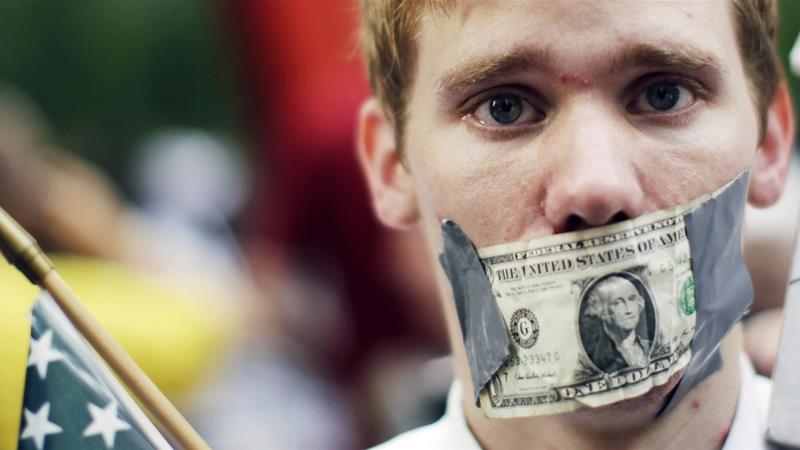
A demonstrator from the Occupy Wall Street campaign seen with a dollar taped over his mouth as he stands near the financial district of New York September 30, 2011. [File: Lucas Jackson/Reuters]
Class and Radical Movements
Fortunately, today’s circumstances in many respects are far more favorable for mass movements to emerge. For one thing, tens of millions of LGBT people are already out of the closet and self-aware in countries around the world.
As pro-black capitalism left most blacks behind in the late 1960s, so too today we can see that pro-pink capitalism does the same for most LGBT people.
Getting LGBT people into high political places no more translates into equality for working-class LGBT people, than getting blacks in high places translates into equality for working-class blacks. A token few in corporate suites and formal laws against discrimination do not alter the fact that real job discrimination persists, especially against trans and intersex people.
Many of us are born into families who hate who we are. All the formal legal equality in the world hasn’t made a dent in the youth homelessness, mental illness, and substance abuse that frequently result from this. Aside from the changes brought about by youth-led Gay-Straight Alliances, little progress has been made in turning the nation’s public schools into universally LGBT-accepting and affirming spaces, something urgently needed when parents, guardians, and other adults are hostile.
In the mid-1960s, with much greater sacrifices, the black Civil Rights Movement won formal equality, only for Black Power activists and King in his later years to point out that much more, and expensive, gains were urgently needed to transform the lives of most in their community.
Likewise, gays, lesbians, and bisexuals have already won most of the easy, inexpensive gains that neoliberalism was willing to concede — equal marriage rights, formal equal housing and employment rights in most of our major cities, employment rights in the military, etc. — precisely because these concessions cost our neoliberal “allies” little or nothing. Truly monumental changes that cost billions in actual and political capital, such as housing for all, including our disproportionately homeless LGBT youth, LGBT-affirming education in all of the public schools, free health care that addresses the needs of LGBTQI people, etc. — are not even part of the conversation.
Stonewall’s Lessons Today
The tasks before us are daunting. The far right is on the march in many countries around the world. Potentially planet-killing climate change may soon become irreversible. Twenty-six billionaires own as much wealth as half of the planet’s population, and yet untold resources are wasted on war and “security.” Neoliberal politicians posing as the alternative to Trump give us tokenism and tell us there aren’t the resources for sweeping change. Indeed, the failure of neoliberal Democrats to give much more than tokenism — while bailing out the banks — is what helped pave the way for the Trump. Other politicians promise some of the sweeping changes we need, but their commitments to US control of much of the world and the military spending it implies make a mockery of these promises.
More fundamentally, their implicit or explicit promises that massive change will come through the “top-down” approach of electing them and other Democrats to make the changes for us is the antithesis of the Stonewall-era movements. In LGBT history, “reform from above,” as in Bill Clinton’s promise to end employment discrimination in the military and the 1977 Dade County, FL equal rights ordinance, has frequently caused disaster rather than progress.
Most of the easy, inexpensive gains of winning formal legal equality are behind us. The much more daunting, expensive ones — housing for all, free health care for all, pro-LGBT education in all public schools — will require a power at least equal to that mustered by the movements of 1968–73. Those movements showed that even a racist, homophobic, warmongering bigot like Richard Nixon could be forced to make massive concessions.
The key to such powerful movements lays not only in their size, but also in their independence from both major parties. With legitimate hatred of Trump running at fever pitch, and Democrats eager to retake power, our task over the next two years and beyond is not only to strengthen those movements numerically, but also prevent their incorporation and defanging by the Democratic Party.
The lessons of the Stonewall movement and its sister movements for today are that the only mechanism for the massive changes we need lies in grassroots struggles. Power for real change lies outside of the parties — in the power that people have to free themselves through their own efforts and organizations.
_______________________________________________
Andy Thayer is a co-founder of the LGBTQ Gay Liberation Network, which takes an intersectional approach to organizing by also supporting abortion rights, anti-police brutality, antiracist, immigrants’ rights, pro-Palestinian, and antiwar activism.
Go to Original – jacobinmag.com
Tags: Activism, Capitalism, Civil Disobedience, Civil Rights, Economics, Gay Rights, History, Homosexuality, Human Rights, Indigenous Rights, Justice, Nonviolence, Peace, Politics, Power, Sexualities, Social justice, Solutions, USA, West, Women Rights, Women liberation, World
DISCLAIMER: The statements, views and opinions expressed in pieces republished here are solely those of the authors and do not necessarily represent those of TMS. In accordance with title 17 U.S.C. section 107, this material is distributed without profit to those who have expressed a prior interest in receiving the included information for research and educational purposes. TMS has no affiliation whatsoever with the originator of this article nor is TMS endorsed or sponsored by the originator. “GO TO ORIGINAL” links are provided as a convenience to our readers and allow for verification of authenticity. However, as originating pages are often updated by their originating host sites, the versions posted may not match the versions our readers view when clicking the “GO TO ORIGINAL” links. This site contains copyrighted material the use of which has not always been specifically authorized by the copyright owner. We are making such material available in our efforts to advance understanding of environmental, political, human rights, economic, democracy, scientific, and social justice issues, etc. We believe this constitutes a ‘fair use’ of any such copyrighted material as provided for in section 107 of the US Copyright Law. In accordance with Title 17 U.S.C. Section 107, the material on this site is distributed without profit to those who have expressed a prior interest in receiving the included information for research and educational purposes. For more information go to: http://www.law.cornell.edu/uscode/17/107.shtml. If you wish to use copyrighted material from this site for purposes of your own that go beyond ‘fair use’, you must obtain permission from the copyright owner.
Read more
Click here to go to the current weekly digest or pick another article:
ACTIVISM:
- CODEPINK Responds to US Senate McCarthy-Style Attack
- Act Now against These Companies Profiting from the Genocide of the Palestinian People
- Conscientious Objectors Refuse to Enlist in the Israeli Army: “Get Out of Gaza Now!”
SEXUALITIES:
